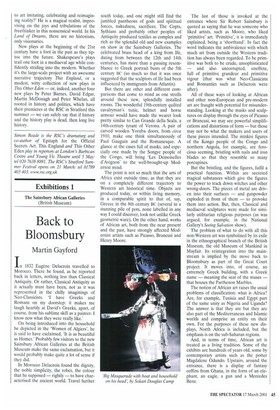The Sainsbury African Galleries (British Museum)
Back to Bloomsbury
Martin Gaylord
In 1832 Eugene Delacroix travelled to Morocco. There he found, as he reported back in letters, nothing less than Classical Antiquity. Or rather, Classical Antiquity as it actually must have been, not as it was represented in the chilly imaginings of Neo-Classicists, 'I have Greeks and Romans on my doorstep: it makes me laugh heartily at David's Greeks, apart, of course, from his sublime skill as a painter. I know now what they were really like.'
On being introduced into the household he depicted in the 'Women of Algiers', he is said to have exclaimed, 'It is as beautiful as Homer.' Probably few visitors to the new Sainsbury African Galleries at the British Museum make the same exclamation, but it would probably make quite a lot of sense if they did.
In Morocco Delacroix found the dignity, the noble simplicity, the robes, the colour that he supposed — rightly — to have characterised the ancient world. Travel further south today, and one might still find the jumbled pantheons of gods and spiritual forces, nakedness, sacrifices. The Copts, Sythians and probably other peoples of Antiquity produced textiles as complex and rich as the splendid old and new examples on show in the Sainsbury Galleries. The celebrated brass head of a king from Ife, dating from between the 12th and 14th centuries, has more than a passing resemblance to Greek portrait busts of the 5th century BC (so much so that it was once suggested that the sculptors of Ife had been influenced by immigrants from Atlantis).
But there are other and different comparisons that come to mind as one strolls around these new, splendidly installed rooms. The wonderful 19th-century quilted cavalryman's tunic, helmet and horse armour would have made the wearer look pretty similar to Can Grande della Scala, a 14th-century tyrant of Verona. A pair of carved wooden Yoruba doors, from circa 1910, make one think simultaneously of Paul Gauguin and the Romanesque. A glance at the cases full of masks, and especially one made by the Songye people of the Congo, will bring 'Les Demoiselles d'Avignon' to the well-brought-up Modernist mind.
The point is not so much that the arts of Africa exist outside time, as that they are on a completely different trajectory to Western art historical time. Objects are produced today, or within living memory, in a comparable spirit to that of, say, Greece in the 8th century BC (several in a stunning pile of pots, none labelled in any way I could discover, look not unlike Greek geometric ware). On the other hand, works of African art, both from the near present and the past, have strongly affected Modernist artists such as Picasso, Brancusi and Henry Moore.
The last of those is invoked at the entrance where Sir Robert Sainsbury is quoted as saying that he was someone who liked artists, such as Moore, who liked 'primitive' art. 'Primitive', it is immediately explained, being a 'shorthand'. In fact the word indicates the ambivalence with which much art from outside the Western tradition has always been regarded. To be primitive was both to be crude, unsophisticated — and also uncorrupted, uneffete, full of primitive grandeur and primitive vigour (that was what Neo-Classicists and Romantics such as Delacroix were after).
All of these ways of looking at African and other non-European and pre-modern art are fraught with potential for misunderstanding. Looking at the masks and sculptures on display through the eyes of Picasso or Brancusi, we may see powerful simplifications and distortions of form — but those may not be what the makers and users of these pieces intended. The minkisi figures of the Kongo people of the Congo and northern Angola, for example, are ferocious seeming, bristling with nails and iron blades so that they resemble so many porcupines.
But the bristling, and the figures, fulfil a practical function. Within are secreted magical substances which give the figures the power to track down witches and other wrong-doers. The pieces of metal are driven into their surfaces — and gunpowder exploded in front of them — to provoke them into action. But, then, Classical and mediaeval sculptures were made for similarly utilitarian religious purposes (as was argued, for example, in the National Gallery's Seeing Salvation show).
The problem of what to do with all this non-Western art was symbolised by its exile in the ethnographical branch of the British Museum, the old Museum of Mankind in Mayfair. Its reintegration into the mainstream is implied by the move back to Bloomsbury as part of the Great Court project. It moves into, of course, an extremely Greek building, with a Greek name — meaning the seat of the muses — that houses the Parthenon Marbles.
The notion of African art raises the usual problems of classification: what is Africa? Are, for example, Tunisia and Egypt part of the same unity as Nigeria and Uganda? The answer is that they are but they are also part of the Mediterranean and Islamic worlds and comprise an entity on their own. For the purposes of these new displays, North Africa is included, but the emphasis is on the sub-Saharan regions.
And, in terms of time, African art is treated as a living tradition. Some of the exhibits are hundreds of years old, some by contemporary artists such as the potter Magdalene Odundo. Upstairs, around the entrance, there is a display of fantasy coffins from Ghana, in the form of an elephant, an eagle, a gun and a Mercedes Benz.


































































 Previous page
Previous page